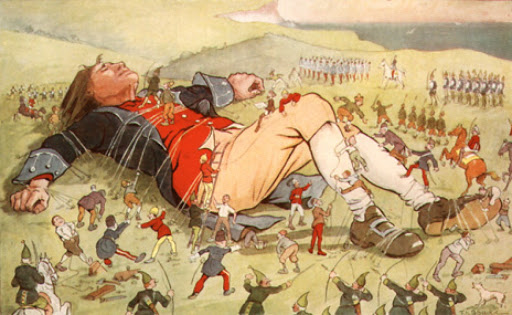Table of Contents
IMAGINARY LITTLE PEOPLE
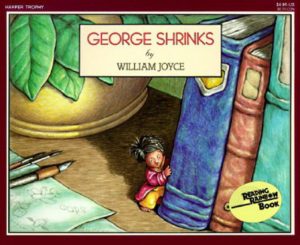
|
In William Joyce’s George Shrinks (HarperCollins, 1987), George wakes up to find that he’s just three inches tall – but he creatively copes, managing to make his bed, brush his teeth, and do the dishes, as well as dealing with the now-gigantic family cat and his even more enormous baby brother. (He also takes a great ride in a toy airplane.) For ages 3-7. |
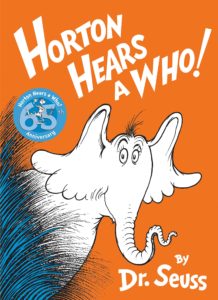
|
Horton the Elephant, the kind and dependable hero of Dr. Seuss’s Horton Hears a Who! (Random House Books for Young Readers, 1954) hears a nearly inaudible cry for help and rescues a small speck of dust from blowing into a pool. The speck turns out to contain an entire population of infinitesimal people, and Horton spends the rest of the book protecting them from disbelieving acquaintances – because, after all, “a person’s a person, no matter how small.” There’s no better role model than Horton. For ages 4-8. |
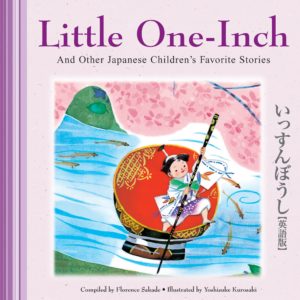
|
Florence Sakade’s Little One-Inch and Other Japanese Children’s Favorite Stories (Tuttle Publishing, 2008) is an illustrated collection of ten different traditional tales, among the “The Spider Weaver,” “The Crab and the Monkey,” and “The Rabbit Who Crossed the Sea.” “Little One-Inch” is the story of a thumb-sized baby boy who grows up to be a tiny samurai warrior, and then sets off to seek his fortune, armed with a needle, and using a soup bowl as a boat, with chopsticks for oars. For ages 4 and up. |
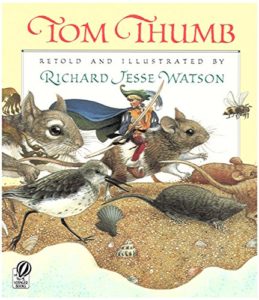
|
Tom Thumb by Richard Jesse Watson (Sandpiper, 1993) is an adaptation of the traditional English tale in which a woman wishes desperately for a baby – even one “no bigger than my husband’s thumb.” Her wish is granted and soon the tiniest of baby boys is born. Named Tom Thumb by the faeries, he grows up to have many adventures, and eventually is knighted by King Arthur. Watson’s illustrations are exquisite paintings filled with natural details: lovingly depicted birds, animals, and plants, Tom’s acorn cradle, and Tom’s field-mouse steed. For ages 4-9. |
| From the Core Knowledge Foundation, Different Lands, Similar Stories is a nine-lesson unit comparing traditional stories across cultures – including tales of supernaturally tiny people. Targeted at grade 3. | |
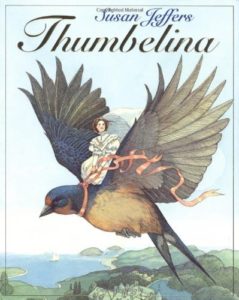
|
My favorite of the many picture-book versions of Hans Christian Andersen’s Thumbelina is Amy Ehrlich’s adaptation, with lovely Victorian-style illustrations by Susan Jeffers (Dutton Juvenile Books, 2005). Like all Andersen tales, Thumbelina is somewhat eerie. The tiny girl who sleeps in a walnut-shell bed under a flower-petal coverlet is first kidnapped by a frightening toad and marooned on a lily pad, and then (almost) forcibly married to a blind mole, before she escapes to find her perfect home with the king of the fairies. For ages 4 and up. |
| For the complete works of Hans Christian Andersen online, see Hans Christian Andersen: Fairy Tales and Stories. | |
| Sur la Lune Fairytales’ Thumbelina has an annotated online text, a gallery of illustrations, a list of related multicultural fairy tales about tiny people, modern interpretations of the story, and a bibliography. | |
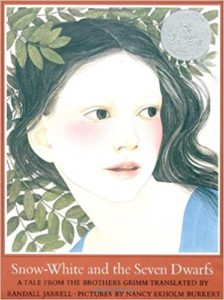
|
Randall Jarrell’s translation of Snow-White and the Seven Dwarfs (Square Fish, 1987) is a stunningly gorgeous version of the story, with illustrations by Nancy Ekholm Burkert. Also see Sur la Lune Fairytales’ Snow White for an annotated text, historical background information, an associated book list, and the names of Disney’s seven dwarfs. |
 |
Julia Roberts as Evil Queen? Mirror Mirror (2012), a Snow-White adaptation, is rated PG. |
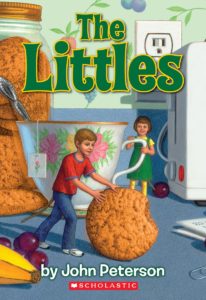
|
John Peterson’s The Littles (Scholastic, 2011) is the first of a series of short chapter books about a tiny family (with mouse-like tails) who lives in the walls of the Bigg family house – and who, in exchange for food and supplies, keep the Bigg house is running order. Then the Biggs go on vacation, leaving the house in the hands of the slovenly Newcombs. What follows is an infestation of mice and a cat. Many sequels. For ages 6-9. |
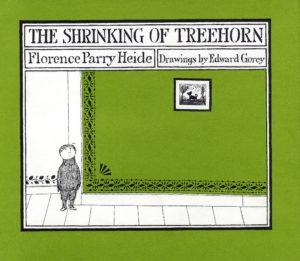
|
In Florence Parry Heide’s The Shrinking of Treehorn (Holiday House, 1992), Treehorn is clearly shrinking, but no one around him seems to notice or care. (“Nobody shrinks,” said Treehorn’s father.) Finally, in the nick of time, Treehorn manages to solve the problem on his own – but even that doesn’t get much of a response. (“That’s nice,” said Treehorn’s mother.) Funny and frustrating, with terrific deadpan illustrations by Edward Gorey. For ages 6 and up. |
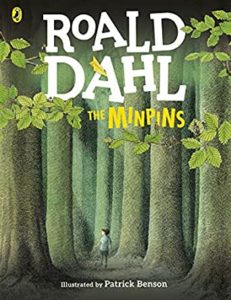
|
In Roald Dahl’s The Minpins (Puffin, 2009), Little Billy – despite awful warnings from his mother – goes into the Forest of Sin where, living in the tops of the trees, he discovers the Minpins, an entire village of miniature people who scamper around in the branches wearing little green boots equipped with suction cups. They are terrified by a monster, the Red-Hot Smoke-Belching Gruncher, and when Billy manages to dispatch it, he ends up with a liberating reward (magical nightly rides on the back of a swan). For ages 5-9. |
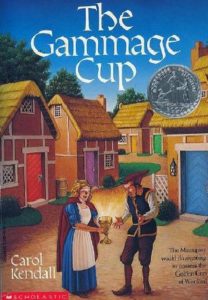
|
The Minnipins of Carol Kendall’s The Gammage Cup (Sandpiper, 2000) are little people – they’re also known as the “Small Ones” – who live in twelve villages scattered along the Watercress River in the Land Between the Mountains. The villages are competing for possession of the Gammage Cup, and the village of Slipper-on-the-Water, ruled by Ltd. and the other elite Periods – all named from abbreviations on a mysterious paper brought by an ancestor from the outside world – is determined to win the prize. The sticking point is five non-conformist citizens – the historian Walter the Earl, the poet Gummy, the artist Curley Green, the curmudgeonly accountant Mingy, and the scatty, but sweet-natured Muggles. Cast out by the prize-obsessed town, the five discover a terrible danger threatening all Minnipins and become heroes. For ages 8-12. |
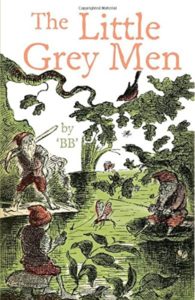
|
The Little Grey Men by BB (a.k.a. Denys Watkins-Pitchford) (HarperCollins, 2004) is the story of the last four gnomes in Britain – Baldmoney, Sneezewort, Dodder, and Cloudberry – who live in a little house under the roots of an old oak tree by the banks of Folly Brook. At the beginning of the book, Cloudberry is missing, and his brothers set off in their little boat – the Dragonfly – to find him. The journey is filled with adventure: wonderful encounters with the birds and animals of Crow Wood; scary encounters with the gamekeeper, Giant Grum, and his dog, Jet; an inadvertently helpful little boy; and a catastrophic storm. The book was originally published in Great Britain in 1942, and is now – yet again – out of print, though can (and should) be obtained through used-book stores and libraries. For ages 8-12. |
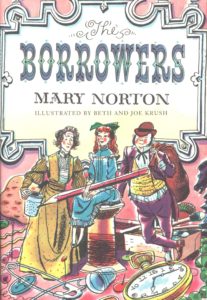
|
Mary Norton’s The Borrowers (Harcourt Children’s Books, 1953), set in the late 19th century, is the story of Pod, Homily, and young Arriety Clock, tiny people who live beneath the floor of an old house in England and survive by “borrowing” matchboxes, buttons, safety pins, and potatoes from the oblivious “human beans.” Then Arrietty, in the teeth of Borrower tradition, befriends a human Boy, with whose help borrowing gets out of hand – which leads to near-disaster. There are four sequels. For ages 9-12. |
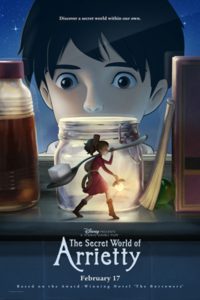 |
Movie versions include Peter Hewitt’s 1997 The Borrowers – a Home-Alone-like production involving hordes of Borrowers and an evil real estate developer; and Hayao Miyazaki’s 2012 anime-style Arrietty, which preserves more of the flavor of the books. |
| For a short Reader’s Theater script based on The Borrowers, see “The Borrower and the Boy” by Aaron Shepard. | |
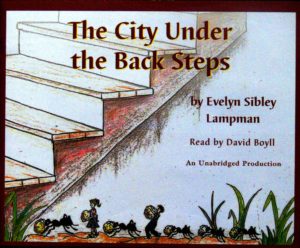
|
In Evelyn Sibley Lampman’s The City Under the Back Steps (Doubleday, 1960), cousins Jill and Craig – who have been stepping on ants – are magically shrunk to the size of ants and imprisoned by the ant colony living under the back steps. There they become integrated into the world of ants: tunneling, gathering food, and eventually forming friendships. Jill endears herself to the ants who work in the colony’s nursery; Craig, armed with a pocketknife, defeats a marauding antlion; and both aid the colony during an attack by hostile red ants. It’s a delightful and adventure-packed book, and a terrific way to learn a lot about ants. That said, it’s out of print – check your local library. |
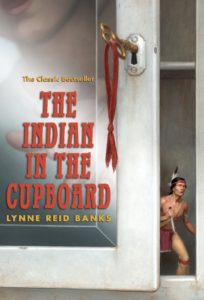
|
In Lynne Reid Banks’s The Indian in the Cupboard (Yearling, 2010), Omri gets a battered cupboard for his birthday – which, when used with a magical key, proves capable of bringing small toys to life. A plastic Indian figure emerges as a miniature human being – a tiny Iroquois warrior named Little Bear. Omri and his friend Patrick, however, soon discover that the cupboard is not a child’s game: the people that emerge from it are real human beings with feelings and lives. There are four sequels: The Return of the Indian, The Secret of the Indian, The Mystery of the Cupboard, and The Key to the Indian. For ages 9-12. |
| The Indian in the Cupboard study unit includes chapter-by-chapter discussion questions, writing prompts, and extension activities, among these making a map of Iroquois territory and building and decorating a cupboard. | |
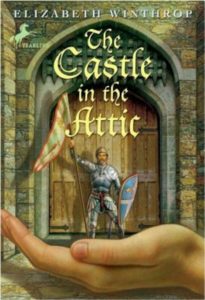
|
In Elizabeth Winthrop’s The Castle in the Attic (Perfection Learning, 2001), William’s beloved nanny, Mrs. Phillips, is returning to England. As a parting gift she gives him the toy castle that had been in her family for generations, together with its little lead inhabitant, the Silver Knight. When William touches the knight, it comes alive in his hand. His name is Sir Simon; he has been under the spell of an evil wizard; and he has a magical amulet that – with the proper magic word – makes things small. Soon Mrs. Phillips and William are both caught up in the magic, and – reduced to tiny size – participate in the quest to free Sir Simon’s country from the cruel rule of the wizard Alastor. There’s a sequel, The Battle for the Castle. For ages 9-12. |
| Carol Hurst’s Children’s Literature Site has a book summary, discussion questions, and activities to accompany The Castle in the Attic. | |
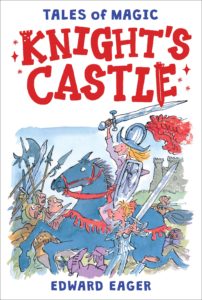
|
In Edward Eager’s Knight’s Castle (Harcourt Young Classics, 1999), Roger and Ann are sent to Baltimore to stay with their cousins Eliza and Jack while their father is in the hospital. Roger brings with him his collection of 256 toy soldiers – among them the mysterious (and magical) Old One, who can (if you earn them) grant wishes. With the help of the Old One, the children become small-sized and enter into the storybook world of the playroom toy castle, where they considerably improve on the ending of Sir Walter Scott’s Ivanhoe. For ages 9-12. |
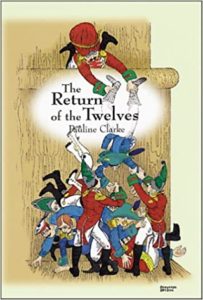
|
The Twelves of Pauline Clarke’s Return of the Twelves (Yearling, 1962) are a troop of old wooden soldiers, discovered in the attic of his family’s farmhouse in Yorkshire by eight-year-old Max – and who, amazingly, come alive when Max beats on a drum. The soldiers, it turns out, once belonged to the Bronte children, and all have names, histories, and personalities. When a rich American collector offers an enormous reward for the soldiers, the Twelves set off on a dangerous cross-country trek to their original home at Haworth Manor – and Max, who has been adopted by the troop as a “Genii” or protector, struggles to see that they get there safely. Not only is it a terrific story, but readers, willy-nilly, learn a lot about the Napoleonic wars, the Bronte family, and the words to the song “The Brave Old Duke of York.” For ages 9-12. It’s out of print, but available at libraries and through used-book sellers. |

|
There are several adaptations of Jonathan Swift’s Gulliver’s Travels for younger readers in which Gulliver, among other adventures, journeys to a land of tiny people called Lilliput. Among these is Jonathan Swift’s Gulliver by Martin Jenkins (Candlewick Press, 2010), an excellent illustrated 144-page re-telling of the classic tale for ages 9-14. |
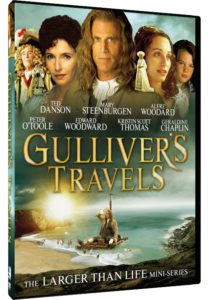 |
The 1996 mini-series of Gulliver’s Travels stars Ted Danson as Gulliver and Peter O’Toole as the King of the Lilliputians. Rated PG. |
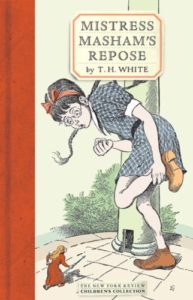
|
Ten-year-old Maria, the heroine of T.H. White’s Mistress Masham’s Repose (NYR Children’s Collection, 2004) is the orphaned mistress of Malplaquet, a vast crumbling palace with 365 windows (all broken but six), where she lives under the thumbs of her guardian, the nasty local vicar Mr. Hater, and her venomous governess, Miss Brown. Then, on an overgrown island in the estate lake, Maria encounters a population of tiny people – descendants of the Lilliputians captured and brought to England by the sea captain who rescued Gulliver. When Mr. Hater and Miss Brown discover the people and attempt to exploit them for their own ends, Maria and her friend, the dotty neighboring Professor, must manage to defeat them. A witty and wonderful read, with plenty of fuel for discussion, for ages 9 and up. |
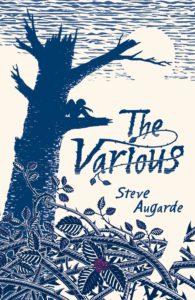
|
In Steve Augarde’s The Various (Yearling, 2005), the first of the Touchstone trilogy, 11-year-old Midge comes to visit her eccentric uncle Brian’s farm and discovers – in the bramble-surrounded neighboring wood – five tribes of tiny people called “the Various,” each with cultures and habitats of their own. Sequels are Celandine and Winter Wood. For ages 9 and up. |
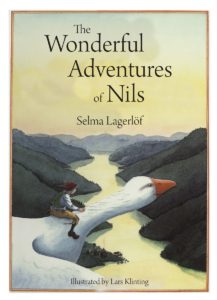
|
In Selma Lagerlof’s classics The Wonderful Adventures of Nils and The Further Adventures of Nils Holgersson (Penfield Press, 2000), originally published in 1906, young Nils – after annoying an elf – is reduced to elf size and then, riding on the back of a wild goose, travels the country of Sweden. Originally commissioned to teach geography to Swedish children, Nils’s adventures cover a lot of historical, cultural, and geographical territory – as well as conveying surprisingly modern insights on the importance of wilderness preservation and environmental stewardship. For ages 9 and up. |
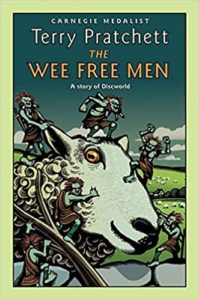
|
In Terry Pratchett’s The Wee Free Men (HarperCollins, 2004), feisty nine-year-old witch-to-be Tiffany Aching’s brother has been nabbed by the fairies, so off she goes to get him back, armed with an iron frying pan. As it turns out, she also has to save the world from monsters; and for help, she has the backing of the Nac Mac Feegle or Wee Free Men, a band of obstreperous, six-inch-tall, bright-blue Scottish pictsies (not pixies). Hilarious and delightful, for ages 10 and up. There’s a sequel: A Hat Full of Sky. |
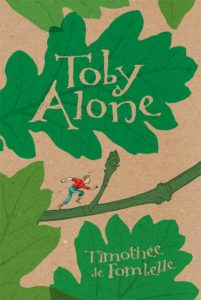
|
Toby Alone by Timothée de Fombelle (Candlewick Press, 2009) features a world of extremely small – no more than two millimeters tall – people who live in a vast oak known simply as the Tree. The tree is in political and social turmoil: thirteen-year-old Toby’s scientist parents have been captured and imprisoned, and he is alone and on the run. The root of the problem is politician/industrialist Joe Mitch, who is bent on exploiting the sap of the Tree for business purposes – a project that will inevitably kill it. Despite its minuscule characters, the book has more in common with 1984 than The Borrowers. This is a complex and sometimes violent story about the uses and abuses of power, and the consequences of environmental destruction. A thought-provoking read for ages 12 and up. The sequel – Toby Alone ends with a cliffhanger – is Toby and the Secrets of the Tree. |
Pages: 1 2
